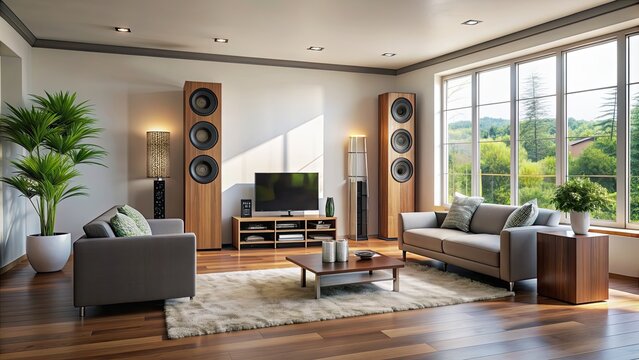When it comes to creating a high-quality listening experience, stereo system speakers play a pivotal role. Whether you’re a casual music listener or an audiophile seeking perfect sound reproduction, the right speakers can make all the difference. But with the vast array of options available today, choosing the best stereo speakers can be an overwhelming task. In this guide, we’ll explore the different types of home audio systems, key factors to consider when buying them, and tips on how to set them up for optimal performance.
What Are Stereo System Speakers?
Stereo system speakers are devices designed to reproduce sound in a way that simulates the experience of listening to live music. They are typically part of a broader audio system that includes other components like amplifiers, audio sources (e.g., turntables, CD players, or streaming devices), and a receiver. The primary job of the speakers is to convert electrical signals into sound waves, which are then projected into the room, creating the auditory experience.
In a stereo setup, the term “stereo” refers to two channels (left and right) of sound, intended to mimic the spatial separation of instruments and vocals, giving the listener the feeling of being immersed in the music. While there are many configurations for home audio setups, stereo speakers are usually the centerpiece when it comes to high-quality sound reproduction.
Types of Stereo System Speakers
Stereo speakers come in various designs, each suited to different needs and preferences. Here’s a breakdown of the main types:
1. Bookshelf Speakers
Bookshelf speakers are compact and versatile, making them ideal for smaller spaces or as part of a home theater system. They are usually designed to sit on a shelf, stand, or table, and despite their size, they can still offer impressive sound quality. Bookshelf speakers are often used in stereo systems for casual listening or in home theater setups as part of the front-stage sound.
Pros:
- Compact and space-saving.
- Suitable for small to medium-sized rooms.
- Affordable compared to larger speakers.
Cons:
- May not produce as much bass as larger speakers.
- Limited volume capacity for larger rooms.
2. Floorstanding (Tower) Speakers
Floorstanding speakers are larger and taller than bookshelf speakers, designed to stand on the floor without the need for additional support. These speakers have multiple drivers (woofers, midrange drivers, and tweeters), allowing them to produce a fuller, more dynamic sound. Floorstanding speakers are ideal for larger rooms or anyone seeking powerful sound reproduction for music or movies.
Pros:
- Superior sound quality with deep bass and wide frequency range.
- Can fill larger spaces with sound without needing a subwoofer.
- Often feature advanced technology for a more immersive audio experience.
Cons:
- Larger and heavier, requiring more space.
- More expensive than bookshelf speakers.
3. Satellite Speakers
Satellite speakers are small speakers that are typically paired with a subwoofer to create a more compact audio system. While they are often used in surround sound setups, they can also be used in stereo configurations, especially in systems where space is a premium.
Pros:
- Compact and lightweight.
- Can be paired with a subwoofer for enhanced bass response.
Cons:
- Limited bass reproduction on their own.
- May not offer the same clarity and depth as larger speakers.
4. In-Wall/In-Ceiling Speakers
In-wall or in-ceiling speakers are installed directly into the walls or ceiling of a room, offering a sleek, unobtrusive solution for those looking to maintain a minimalist aesthetic. These speakers are commonly used in custom home audio installations and can provide a clean sound with less clutter.
Pros:
- Space-saving and aesthetically pleasing.
- Can blend seamlessly into the room’s design.
Cons:
- Installation can be complex and may require professional help.
- Limited flexibility in terms of positioning.
5. Portable Speakers
Portable stereo speakers are small, lightweight, and designed for on-the-go use. Many are Bluetooth-enabled, allowing you to wirelessly stream music from smartphones, tablets, or laptops. While these speakers are great for outdoor activities and casual listening, they typically don’t offer the same high-quality sound as stationary home audio speakers.
Pros:
- Compact and easy to carry.
- Bluetooth functionality for wireless streaming.
Cons:
- Limited sound quality, especially at high volumes.
- Smaller drivers, meaning less bass response.
Key Features to Consider When Buying Stereo System Speakers
1. Frequency Response
The frequency response of a speaker defines the range of sound frequencies it can reproduce, typically measured in Hertz (Hz). A wider frequency response means the speaker can produce more detailed sound, from low bass to high treble. For most listeners, a range of 40 Hz to 20 kHz is sufficient for full-range sound.
2. Sensitivity
Sensitivity refers to how efficiently a speaker converts power into sound. It’s measured in decibels (dB). Speakers with higher sensitivity (e.g., 90 dB or more) will produce louder sounds at lower power levels compared to speakers with lower sensitivity. If you’re using a low-power amplifier or receiver, you may want to prioritize speakers with higher sensitivity.
3. Impedance
Impedance is the resistance a speaker offers to the flow of electrical current. Most speakers have an impedance of 4, 6, or 8 ohms. Lower impedance speakers draw more current, requiring more powerful amplifiers, while higher impedance speakers are easier on the amp but may not produce the same volume. Ensure your amplifier and speakers are compatible in terms of impedance to avoid damage to the system.

